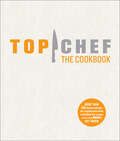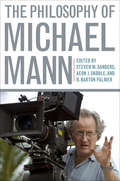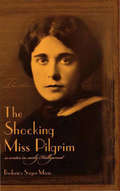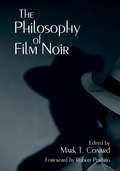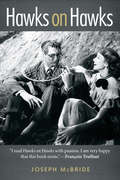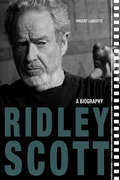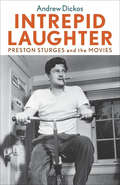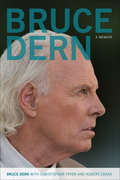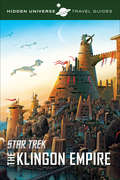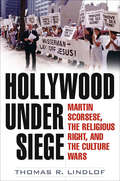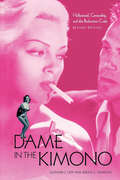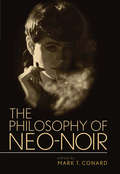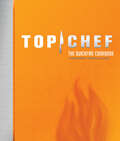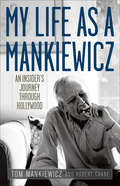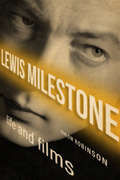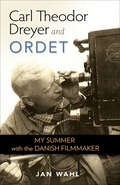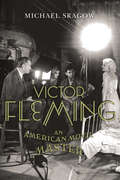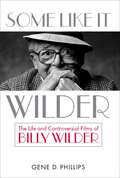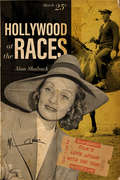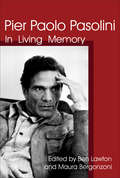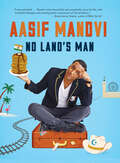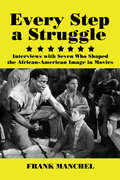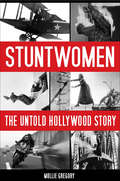- Table View
- List View
Top Chef: The Cookbook
by Bravo MediaThe creators of Bravo’s Top Chef share inside stories and more than 100 recipes in this New York Times bestselling cookbook and series companion.In Top Chef: The Cookbook, Tom Colicchio invites fans and home chefs into the hottest kitchen on prime time. This volume features some of the most memorable winning recipes from the first three seasons, as well as dishes from the Elimination Rounds and the Quick-Fire Challenges. Here you’ll find Elia Aboumrad’s Breakfast, Lunch, and Dinner Waffles; C.J. Jacobson’s Crepes; Hung Huynh’s Tuna Tartare; Lea Anne Wong’s Deep Fried Oysters; Tre Wilcox III’s Bacon wrapped Shrimp; and much more.In-depth discussions with contestants, judges, and crew reveal the inner workings of the show, and lavish photographs take readers behind-the-scenes into the Top Chef pantry and competition sites. This cookbook will have aspiring culinary contenders reliving classic show moments and relishing new recipes!
The Philosophy of Michael Mann (The Philosophy of Popular Culture)
by Aeon J. Skoble R. Barton Palmer Steven SandersA collection of essays exploring the philosophical themes and aesthetic vision behind blockbuster film including The Insider, Public Enemies,and more.Known for his finely crafted crime thrillers, American filmmaker Michael Mann has long been regarded as a talented triple threat capable of moving effortlessly between television and feature films as a writer, director, and executive producer. His unique visual sense and thematic approach are evident in the Emmy Award-winning The Jericho Mile, the cult favorite The Keep, the American epic The Last of the Mohicans, and the Academy Award-nominated The Insider, as well as more recent works such as Ali, Miami Vice, and Public Enemies.The Philosophy of Michael Mann provides a comprehensive account of the work of this highly accomplished filmmaker, exploring the director's recognizable visual style and the various on-screen and philosophical elements he has tested in his thirty-five-year career. The essays in this wide-ranging book will appeal to fans of the revolutionary filmmaker and to philosophical scholars interested in the themes and conflicts that drive his movies.
The Shocking Miss Pilgrim: A Writer in Early Hollywood
by Frederica Sagor MaasA memoir of the rise and fall of one female screenwriter&’s career during the Golden Age of Hollywood. Freddie Maas&’s revealing memoir offers a unique perspective on the film industry and Hollywood culture in their early days and illuminates the plight of Hollywood writers working within the studio system. An ambitious twenty-three-year-old, Maas moved to Hollywood and launched her own writing career by drafting a screenplay of the bestselling novel The Plastic Age for &“It&” girl Clara Bow. With that script, she landed a staff position at powerhouse MGM studios. In the years to come, she worked with and befriended numerous actors and directors, including Norma Shearer, Joan Crawford, and Eric von Stroheim, as well as such writers and producers as Thomas Mann and Louis B. Mayer. As a professional screenwriter, Frederica quickly learned that scripts and story ideas were frequently rewritten, and that screen credit was regularly given to the wrong person. Studio executives wanted well-worn plots, but it was the writer&’s job to develop the innovative situations and scintillating dialogue that would bring to picture to life. For over twenty years, Freddie and her friends struggled to survive in this incredibly competitive environment. Through it all, Freddie remained a passionate, outspoken woman in an industry run by powerful men, and her provocative, nonconformist ways brought her success, failure, wisdom, and a wealth of stories, opinions, and insight into a fascinating period in screen history.Praise for The Shocking Miss Pilgrim &“In this memorable tell-all, rise-and-fall memoir, Maas brings the gimlet hindsight of Julia Phillips&’s You&’ll Never Eat Lunch in This Town Again to early Hollywood, and the results are thoroughly captivating.&” —Publishers Weekly &“A bittersweet, extraordinarily detailed recollection of Maas&’s 30-year career in the motion picture industry. . . . Chockablock with anecdotes, and a blinding amount of star-wattage to boot.&” —Salon.com
The Philosophy of Film Noir (The Philosophy of Popular Culture #Ppcs)
by Mark T. ConardAn essay collection examining the philosophical elements of select films in noir cinema, as well as the genre’s legacy in film and culture.A drifter with no name and no past, driven purely by desire, is convinced by a beautiful woman to murder her husband. A hard-drinking detective down on his luck becomes involved with a gang of criminals in pursuit of a priceless artifact. The stories are at once romantic, pessimistic, filled with anxiety and a sense of alienation, and they define the essence of film noir. Noir emerged as a prominent American film genre in the early 1940s, distinguishable by its use of unusual lighting, sinister plots, mysterious characters, and dark themes. From The Maltese Falcon (1941) to Touch of Evil (1958), films from this classic period reflect an atmosphere of corruption and social decay that attracted such accomplished directors as John Huston, Alfred Hitchcock, Billy Wilder, and Orson Welles.The Philosophy of Film Noir is the first volume to focus exclusively on the philosophical underpinnings of these iconic films. Drawing on the work of diverse thinkers, from the French existentialist Albert Camus to the Frankurt school theorists Max Horkheimer and Theodor Adorno, the volume connects film noir to the philosophical questions of a modern, often nihilistic, world. Opening with an examination of what constitutes noir cinema, the book interprets the philosophical elements consistently present in the films—themes such as moral ambiguity, reason versus passion, and pessimism. The contributors to the volume also argue that the essence and elements of noir have fundamentally influenced movies outside of the traditional noir period. Neo-noir films such as Pulp Fiction (1994), Fight Club (1999), and Memento (2000) have reintroduced the genre to a contemporary audience. As they assess the concepts present in individual films, the contributors also illuminate and explore the philosophical themes that surface in popular culture.A close examination of one of the most significant artistic movements of the twentieth century, The Philosophy of Film Noir reinvigorates an intellectual discussion at the intersection of popular culture and philosophy.Praise for The Philosophy of Film Noir“The essays work both as solid primers into philosophy, stretching from Aristotle to Schopenhauer, and as lucid excursions into the genre’s dark, mean streets. . . . A fascinating, readable, and provocative book. . . . Highly recommended.” —Choice“Dense and intriguing, the book suggests noir is best perceived as a slightly warped mirror held up to contemporary society.” —Publishers Weekly
Hawks on Hawks (Screen Classics)
by Joseph McBrideA portrait of the renowned film director based on seven years of interviews: “I am very happy that this book exists.” —François TruffautHoward Hawks is often credited as the most versatile of the great American directors, having worked with equal ease in screwball comedies, westerns, gangster movies, musicals, and adventure films. He directed an impressive number of Hollywood’s greatest stars—including Humphrey Bogart, Cary Grant, John Wayne, Lauren Bacall, Rosalind Russell, and Marilyn Monroe—and some of his most celebrated films include Scarface, Bringing Up Baby, The Big Sleep, Red River, Gentlemen Prefer Blondes, and Rio Bravo.Hawks on Hawks draws on interviews that author Joseph McBride conducted with the director over the course of seven years, giving rare insight into Hawks’s artistic philosophy, his relationships with the stars, and his position in an industry that was rapidly changing. In its new edition, this classic book is both an account of the film legend’s life and work and a guidebook on how to make movies.“There are going to be many biographies of Howard Hawks, but they will all lean heavily on this book; the pioneer so honestly reveals himself and the people with whom he worked.” —Los Angeles Times
Ridley Scott: A Biography (Screen Classics)
by Vincent LoBruttoA study of the iconic and influential film director’s life and work, from the author of Stanley Kubrick: A Biography.With celebrated works such as Alien, Blade Runner, Thelma & Louise, and Gladiator, Ridley Scott has secured his place in Hollywood. This legendary director and filmmaker has had an undeniable influence on art and the culture of filmmaking, but is also a respected media businessman.In Ridley Scott: A Biography, Vincent LoBrutto delves into Ridley Scott’s oeuvre in a way that allows readers to understand the yin and yang of his exceptional career, offering a unique crosscut between the biographical facts of Scott’s personal life—his birth and early days in northeast England, his life in New York City—and his career in Hollywood as a director and producer of television commercials, TV series, miniseries, and feature films.Every film is presented, analyzed, and probed for a greater understanding of the visionary, his personality, and his thought process, for a deeper perception of his astounding work and accomplishments. The voices of cast and crew who have worked with Ridley Scott, as well as the words of the man himself, are woven throughout this book for a fully realized, critical biography, revealing the depth of the artist and his achievements.
Intrepid Laughter: Preston Sturges and the Movies (Screen Classics)
by Andrew DickosThe life and career of the pioneering writer-director whose name is synonymous with sophisticated screwball comedies.Preston Sturges was known for bringing sophistication and wit to the genre of comedy, establishing himself as one of the most valuable writer-directors in 1940s Hollywood. Today, more than a half century after they were originally produced, his films have lost little of their edge and remain extremely popular.Intrepid Laughter is an essential guide to the life and work of this luminary of the stage and screen, following Sturges from his unusual childhood, to his early success as a Broadway playwright, to his whirlwind career in Hollywood.
Bruce Dern: A Memoir (Screen Classics)
by Robert Crane Christopher Fryer Bruce DernThis memoir by the Academy Award nominee “proves that Dern off-screen is every bit as unpredictable, compelling and explosively honest as he is onscreen” (Newsday).One of Hollywood’s biggest personalities, Bruce Dern is not afraid to say what he thinks. He has left an indelible mark on numerous projects, from critically acclaimed films to made-for-TV movies and television series. His notable credits include The Great Gatsby, The 'Burbs, Monster, Django Unchained, and Nebraska, for which he won the Best Actor award at the 2013 Cannes Film Festival. He also earned Oscar nominations for Best Supporting Actor in Coming Home and for Best Actor in Nebraska.In Bruce Dern: A Memoir, Christopher Fryer and Robert Crane help the outspoken star frame the fascinating tale of his life in Hollywood. Dern details the challenges he faced as an artist in a cutthroat business, his struggle against typecasting, and his thoughts on and relationships with other famous figures, including Elia Kazan, Alfred Hitchcock, Jack Nicholson, Paul Newman, Bob Dylan, Matt Damon, Jane Fonda, John Wayne, and Tom Hanks. He also explores the impact of his fame on his family and discusses his unique relationship with his daughter, actress Laura Dern.Edgy and uncensored, this memoir—filled with “amusing, illuminating, and occasionally heartrending anecdotes” (Philadelphia Inquirer)—is a wild ride and an insider’s view of fifty years in the film industry.
Star Trek: The Klingon Empire (Hidden Universe Travel Guides)
by Insight EditionsExplore the homeworld and vast dominion of Star Trek&’s formidable Klingons in this &“fun and engaging&” travel guide full of &“fascinating facts&”(Starburst Magazine). nuqneH! Bored of standard vacations to places like Risa or Wrigley&’s Pleasure Planet? Want to discover a unique and ancient culture not bound by standard niceties and social mores? Then Qo&’noS and the vast Klingon Empire are for you! This one-of-a-kind travel guide will give you all the information you need to plan, enjoy, and survive your trip to the very heart of Klingon territory, from an overview of Klingon history to tips on what to wear (fur and leather are very popular) to a glossary of important phrases like &“mamI' DaneH'a'? nItebHa' mamI' DaneH'a'?&” (Would you like to dance with me?). Every major location in the Klingon Empire is covered in depth, with tips on where to eat (you&’ve not lived until you&’ve eaten Klingon skull stew), how best to get to and from your chosen destination, and what to do if you find yourself challenged to a bat&’leth battle to the death. Locations include the homeworld Qo&’noS and its famous locales such as the First City, the Caves of No&’mat, the Hamar Mountains, and the city of Krennla, plus neighboring moons Corvix and Praxis, and many, many more must-see areas. The book also features exclusive maps and illustrations that bring to life the Klingon Empire and form the perfect reference guide for any visitor. So what are you waiting for? Qapla&’!
Hollywood Under Siege: Martin Scorsese, the Religious Right, and the Culture Wars
by Thomas R. LindlofA behind-the-scenes look at the making of The Last Temptation of Christ and the controversy following its release.In 1988, director Martin Scorsese fulfilled his lifelong dream of making a film about Jesus Christ. Rather than celebrating the film as a statement of faith, churches and religious leaders immediately went on the attack, alleging blasphemy. At the height of the controversy, thousands of phone calls a day flooded the Universal switchboard, and before the year was out, more than three million mailings protesting the film fanned out across the country. For the first time in history, a studio took responsibility for protecting theaters and scrambled to recruit a “field crisis team” to guide The Last Temptation of Christ through its contentious American openings. Overseas, the film faced widespread censorship actions, with thirteen countries eventually banning the film. The response in Europe turned violent when opposition groups sacked theaters in France and Greece and caused injuries to dozens of moviegoers.Twenty years later, author Thomas R. Lindlof offers a comprehensive account of how this provocative film came to be made and how Universal Pictures and its parent company MCA became targets of the most intense, unremitting attacks ever mounted against a media company. The film faced early and determined opposition from elements of the religious Right when it was being developed at Paramount during the last year the studio was run by the celebrated troika of Barry Diller, Michael Eisner, and Jeffrey Katzenberg. By the mid-1980s, Scorsese’s film was widely regarded as unmakeable?a political stick of dynamite that no one dared touch. Through the joint efforts of two of the era’s most influential executives, CAA president Michael Ovitz and Universal Pictures chairman Thomas P. Pollock, this improbable project found its way into production. The making of The Last Temptation of Christ caught evangelical Christians at a moment when they were suffering a crisis of confidence in their leadership. The religious right seized on the film as a way to rehabilitate its image and to mobilize ordinary citizens to attack liberalism in art and culture. The ensuing controversy over the film’s alleged blasphemy escalated into a full-scale war fought out very openly in the media. Universal/MCA faced unprecedented calls for boycotts of its business interests, anti-Semitic rhetoric and death threats were directed at MCA chairman Lew Wasserman and other MCA executives, and the industry faced the specter of violence at theaters.Hollywood Under Siege draws upon interviews with many of the key figures?Martin Scorsese, Paul Schrader, Michael Ovitz, Jeffrey Katzenberg, Jack Valenti, Thomas P. Pollock, and Willem Dafoe?to explore the trajectory of the film from its conception to the subsequent epic controversy and beyond. Lindlof offers a fascinating dissection of a critical episode in the embryonic culture wars, illuminating the explosive effects of the clash between the interests of the media industry and the forces of social conservatism.Praise for Hollywood Under Siege“No other book has traced the development of a major motion picture from conception through production to reception with the kind of care and detail that Lindlof does here. Hollywood Under Siege provides valuable insight into the machinery of the film industry, and into the machinations of American culture on a broader front as well.” —Thomas Schatz, author of The Genius of the System: Hollywood Filmmaking in the Studio Era and Executive Director of the University of Texas Film Institute“Riveting and accurate. Even though I thought I knew the events, I found myself captured anew.” —Paul Schrader, screenwriter and director“As a study of a landmark moment in American cinema, Lindlof’s book is both profound and extremely entertaining.” —Los Angeles Times“Lindlof has meticulously researched the histo
The Dame in the Kimono: Hollywood, Censorship, and the Production Code
by Leonard J. Leff Jerold L. Simmons“This excellent, lively study examines the ‘raucous debate’ sparked by the Code over the morals and ideals of American movies.” —Publishers WeeklyThe new edition of this seminal work takes the story of the Production Code and motion picture censorship into the present, including the creation of the PG-13 and NC-17 ratings in the 1990s.Starting in the early 1930s, the Production Code Director, Joe Breen, and his successor, Geoff Shurlock, understood that American motion pictures needed enough rope—enough sex, and violence, and tang—to lasso an audience, and not enough to strangle the industry. To explore the history and implementation of the Motion Picture Production Code, this book uses 11 movies: Dead End, GoneWith the Wind, The Outlaw, The Postman Always Rings Twice, The Bicycle Thief, Detective Story, A Streetcar Named Desire, The Moon Is Blue, The French Line, Lolita, and Who’s Afraid of Virginia Woolf? The authors combine a lively style with provocative insights and a wealth of anecdotes to show how the code helped shape American screen content for nearly 50 years.“A readable, intimate account of the rise to near-tyrannical power, and the fall to well-deserved ignominy, of the old Production Code Administration.” —Atlantic Monthly“A valuable insight into our own innocence and naiveté.” —The New York Times Book Review“The triumph of Leff and Simmons’s fine work is that they have reminded us of how fatuous and inimical a code of conduct can be: how tempting it is as a theoretical answer, and how intrinsically flawed it is as a working solution.” —The Times of London
The Philosophy of Neo-Noir (The Philosophy of Popular Culture #Ppcs)
by Mark T. ConardA collection of essays exploring the philosophical elements present in Neo-Noir films.Film noir is a classic genre characterized by visual elements such as tilted camera angles, skewed scene compositions, and an interplay between darkness and light. Common motifs include crime and punishment, the upheaval of traditional moral values, and a pessimistic stance on the meaning of life and on the place of humankind in the universe. Spanning the 1940s and 1950s, the classic film noir era saw the release of many of Hollywood’s best-loved studies of shady characters and shadowy underworlds, including Double Indemnity, The Big Sleep, Touch of Evil, and The Maltese Falcon. Neo-noir is a somewhat loosely defined genre of films produced after the classic noir era that display the visual or thematic hallmarks of the noir sensibility.The essays collected in The Philosophy of Neo-Noir explore the philosophical implications of neo-noir touchstones such as Blade Runner, Chinatown, Reservoir Dogs, Memento, and the films of the Coen brothers. Through the lens of philosophy, Mark T. Conard and the contributors examine previously obscure layers of meaning in these challenging films. The contributors also consider these neo-noir films as a means of addressing philosophical questions about guilt, redemption, the essence of human nature, and problems of knowledge, memory and identity. In the neo-noir universe, the lines between right and wrong and good and evil are blurred, and the detective and the criminal frequently mirror each other's most debilitating personality traits. The neo-noir detective?more antihero than hero?is frequently a morally compromised and spiritually shaken individual whose pursuit of a criminal masks the search for lost or unattainable aspects of the self. Conard argues that the films discussed in The Philosophy of Neo-Noir convey ambiguity, disillusionment, and disorientation more effectively than even the most iconic films of the classic noir era. Able to self-consciously draw upon noir conventions and simultaneously subvert them, neo-noir directors push beyond the earlier genre's limitations and open new paths of cinematic and philosophical exploration.Praise for The Philosophy of Neo-Noir“Conard can feel confident that these terrific essays will be of interest to film enthusiasts, particularly fans of Neo-Noir. Additionally, for those who come to this volume with some background in philosophy, not only will they be pleased to find fellow philosophers offering accessible introductions to philosophical thinkers and ideas but they are sure to increase their understanding of noir, Neo-Noir, and many familiar film titles, as well as more deeply appreciate the ways in which popular film and television offer wide and varied avenues to doing good philosophy.” —Kimberly A. Blessing, co-editor of Movies and the Meaning of Life“Taking up such latter-day classics as Chinatown, Blade Runner, and Memento, this volume explores how contemporary filmmakers have taken up the challenge of classic film noir and broadened the genre. In this analysis, even the pastel shades of South Beach take on a dark coloring in Miami Vice. These probing essays locate what is neo in Neo-Noir and thus define it as a postmodern genre.” —Paul Cantor, author of Gilligan Unbound: Pop Culture in the Age of Globalization“This collection will serve as a terrific interdisciplinary guide through the chaotic, intriguing world of postmodernist thought as it relates to film and philosophy.” —Choice
Top Chef: The Quickfire Cookbook
by Bravo MediaThe creators of Bravo’s Top Chef share seventy-five Quickfire memorable recipes in this cookbook featuring tips, photos, contestant interviews, and more.The much-anticipated follow-up to the New York Times best-selling Top Chef: The Cookbook is here! Drawing from the first five seasons of the show, Top Chef: The Quickfire Cookbook features 75 of the best recipes—from Spike’s Pizza alla Greek to Stephanie’s Bittersweet Chocolate Cake—culled from the Top Chef Quickfire Challenges. Everything the home chef needs to assemble an impressive meal and channel the energy of the Quickfire kitchen is collected here, including advice on hosting a Quickfire Cocktail Party and staging your own Quickfire Challenges at home. Best of all, this book is spilling over with sidebar material, including tips for home chefs, interviews with contestants, fabulous photos, and fun trivia related to the chefs, dishes, and ingredients that make Top Chef a favorite.
My Life as a Mankiewicz: An Insider's Journey Through Hollywood (Screen Classics)
by Robert Crane Tom Mankiewicz“A treasure trove of observations and anecdotes about Hollywood from the 1960s to the 1980s and the people who made the movies back then.” —Associated PressThe son of famed director and screenwriter Joseph L. Mankiewicz and the nephew of Citizen Kane screenwriter Herman Mankiewicz, Tom Mankiewicz was genuine Hollywood royalty. He grew up in Beverly Hills and New York, spent summers on his dad’s film sets, had his first drink with Humphrey Bogart, dined with Elizabeth Taylor and Richard Burton, went to the theater with Ava Gardner, and traveled the world writing for Brando, Sinatra, and Connery. Although his family connections led him to show business, Tom “Mank” Mankiewicz forged a career of his own, becoming a renowned screenwriter, director, and producer of acclaimed films and television shows. He wrote screenplays for three James Bond films—Diamonds Are Forever (1971), Live and Let Die (1973), and The Man with the Golden Gun (1974)—and made his directorial debut with the hit TV series Hart to Hart (1979-1984). My Life as a Mankiewicz is a fascinating look at the life of an individual whose creativity and work ethic established him as a member of the Hollywood writing elite.My Life as a Mankiewicz illuminates his professional development as a writer and director, detailing his friendships and romantic relationships with some of Hollywood’s biggest stars as well as his struggle with alcohol and drugs. With the assistance of Robert Crane, Mankiewicz tells a story of personal achievement and offers an insider’s view of the glamorous world of Hollywood during the 1960s, 1970s, and 1980s.
How to Cook Like a Top Chef
by Bravo MediaRecipes, techniques, photos, and interviews from Bravo’s hit show!The best food show on cable TV presents the ultimate guide to becoming a Top Chef. This combination cookbook and culinary primer features recipes from the show (and from season one of Top Chef: Masters), along with insider techniques from favorite contestants and judges.Covering everything from knife skills to sauces and sous-vide, How to Cook Like a Top Chef teaches aspiring chefs what it takes to be a star in the kitchen. Packed with exclusive content, including a foreword by Top Chef: Masters winner Rick Bayless, original recipes from contestants, behind-the-scenes interviews, juicy trivia, and tons of tips and tricks, this volume is indispensable on the cook’s countertop and essential reading for Top Chef fans.
Lewis Milestone: Life and Films (Screen Classics)
by Harlow RobinsonA biography of the Oscar-winning director and a study of his acclaimed films, like All Quiet on the Western Front, The Front Page, and Of Mice and Men. This comprehensive biography is the first to present Lewis Milestone&’s remarkable life—a classic rags-to-riches American narrative—in full and explores his many acclaimed films from the silent to the sound era. Creator of All Quiet on the Western Front, Of Mice and Men, the original Ocean&’s Eleven and Mutiny on the Bounty, Lewis Milestone (1895-1980) was one of the most significant, prolific, and influential directors of our time. A serious artist who believed in film&’s power not only to entertain, but also to convey messages of social importance, Milestone was known as a man of principle in an industry not always known for an abundance of virtue. Born in Ukraine, Milestone came to America as a tough, resourceful Russian-speaking teenager and learned about film by editing footage from the front as a member of the Signal Corps of the US Army during World War I. During the course of his film career, which spanned more than 40 years, Milestone developed intense personal and professional relationships with such major Hollywood figures as Howard Hughes, Kirk Douglas, Marlene Dietrich, and Marlon Brando. Addressed are Milestone&’s successes?he garnered 28 Academy Award nominations?as well as his challenges. Using newly available archival material, this work also examines Milestone&’s experience during the Hollywood Blacklist period, when he was one of the first prominent Hollywood figures to fall under suspicion for his alleged Communist sympathies.Praise for Lewis Milestone&“This highly readable biography of Lewis Milestone delivers the definitive study of a leading Jewish émigré director in Hollywood from the 1920s to the 1960s who worked successfully across multiple genres. Robinson seamlessly layers the scholarly expertise of a noted film historian of Russia and the Soviet Union with a novelist&’s gift for narrative power and dramatic flair, bringing long overdue attention to Milestone&’s fascinating life and enduring artistic achievements.&” —Catherine Portuges, University of Massachusetts Amherst&“A welcome biography of a man whose films remain better known than his name . . . . Robinson concentrates on the key aspects of Milestone&’s life and career, never getting bogged down in plot synopses or other minor issues. Rather than shoveling up endless rubble, he offers us the milestones of Milestone. Robinson&’s story is as tight as most classic Hollywood films, and that deserves to be heralded. This is a book equally as valuable to film buffs as to academic scholars, speaking to readers inside and outside the academy.&” —LA Review of Books
Carl Theodor Dreyer and Ordet: My Summer with the Danish Filmmaker (Screen Classics)
by Jan WahlThis illustrated memoir shares a rare inside look at the legendary director’s process and vision during the filming of his award-winning masterpiece.Danish director Carl Theodor Dreyer is considered one of the most influential filmmakers in cinematic history. His 1955 film Ordet (The World) won numerous prizes, including the Venice Film Festival’s Golden Lion. In 1954, Dreyer invited young film student Jan Wahl to accompany him during this classic work.This captivating account of Wahl's time with the director is based on Wahl's daily journal and transcriptions of his conversations with Dreyer. Offering a glimpse into the filmmaker's world, Wahl fashions a portrait of Dreyer as a man, mentor, friend, and director. Wahl's detailed account is supplemented by exquisite photos of the filming and by selections from Dreyer's papers, including his notes on film style, his introduction for the actors before the filming of Ordet, and a visionary lecture he delivered at Edinburgh.
Victor Fleming: An American Movie Master (Screen Classics)
by Michael SragowThis definitive biography chronicles the life and work of the legendary director of Gone With the Wind and The Wizard of Oz.Victor Fleming was the most sought-after director in Hollywood’s golden age, renowned for his work across an astounding range of genres—from gritty westerns to screwball comedies, romances, boddy pictures, and family entertainment. Yet this chameleon-like versatility has resulted in his relative obscurity today—despite his having directed two of the most iconic movies of all time.Fleming is best remembered for Gone With the Wind and The Wizard of Oz, but he directed more than forty films, including classics like Red Dust, Test Pilot, Dr. Jekyll and Mr. Hyde, and Captains Courageous. Fleming created enduring screen personas for Clark Gable, Spencer Tracy, and Gary Cooper, as well as for Ingrid Bergman, Clara Bow, and Norma Shearer—who were among his many lovers.In this definitive biography, Michael Sragow restores the director to the pantheon of great American filmmakers, correcting a major oversight in Hollywood history. It is the dramatic story of a man at the center of the most exciting period in American filmmaking.
Some Like It Wilder: The Life and Controversial Films of Billy Wilder (Screen Classics #Sccl)
by Gene D. PhillipsA biography of the six-time Oscar-winning director of films like Some Like It Hot and Double Indemnity, featuring analysis of his work.Although his career spanned fifty years and included more than fifty films, Austrian-American film director Billy Wilder (1906-2002) may be best known for the legendary shot of Marilyn Monroe’s dress billowing over a subway grating in The Seven Year Itch (1955). This “shot seen round the world” is representative not only of Hollywood’s golden era of cinema but also of one of its most prolific and brilliant directors. Wilder, whose filmography includes such classics as Sunset Boulevard (1950), Sabrina (1954), Witness for the Prosecution (1957), and Some Like It Hot (1959), is often remembered for his versatility, biting wit, and passion for challenging social and moral conventions.Author Gene D. Phillips departs from the traditional biography in Some Like It Wilder, offering new insights into the acclaimed director’s professional and private life. In preparation for the book, Phillips conducted personal interviews with Wilder and other key players from the legendary director’s life and times. Phillips’s unique combination of analysis and biographical detail brings Wilder to life, as both an artist and man.Phillips traces Wilder’s path from Berlin, where he worked as a scriptwriter for one of the city’s largest studios, to Hollywood, where he would quickly establish himself as a premier film director. Forming a partnership with writer-producer Charles Brackett, Wilder directed the classic films Five Graves to Cairo (1943), Double Indemnity (1945), and The Lost Weekend (1945), which earned Academy Awards for best picture, best director, and best screenplay. During the 1960s, Wilder continued to direct and produce controversial comedies, including Kiss Me Stupid (1964) and The Apartment (1960). The Apartment brought Wilder another round of Oscars for best picture, best director, and best screenplay.Wilder’s maverick approach and independent artistic vision pushed boundaries and ensured his legacy as one of the Hollywood greats. Sharply written, Some Like It Wilder serves as a comprehensive companion to Wilder’s films, offering a personalized and heartfelt account of the life and genius of this compelling director.Praise for Some Like It Wilder“Featuring Gene D. Phillips’ unique, in-depth critical approach, Some Like It Wilder . . . provides a groundbreaking overview of a filmmaking icon . . . . This definitive biography reveals that Wilder was, and remains, one of the most influential directors in filmmaking.” —Turner Classic Movies“[Phillips] goes beyond the surface and deep into the complex mind and soul of the famous film director . . . . This book is, in my view, definitive.” —Vincent LoBrutto, author of Martin Scorsese: A Biography
Hollywood at the Races: Film's Love Affair with the Turf
by Alan Shuback“An informative and amusing look at the close relationship between Golden Age Hollywood and West Coast horse racing. A fascinating read.” —Christina Rice, author of Mean . . . Moody . . . Magnificent!Horse racing was so popular and influential between 1930 and 1960 that nearly 150 racing themed films were released, including A Day at the Races, Thoroughbreds Don’t Cry, and National Velvet.This fast-paced, gossipy history explores the relationship between the Hollywood film industry, the horse racing industry, and the extraordinary participation of producers, directors, and actors in the Sport of Kings. Alan Shuback details how all three of Southern California’s major racetracks were founded by Hollywood luminaries: Hal Roach was cofounder of Santa Anita Park, Bing Crosby founded Del Mar with help from Pat O’Brien, and Jack and Harry Warner founded Hollywood Park with help from dozens of people in the film community.The races also provided a social and sporting outlet for the film community—studios encouraged film stars to spend a day at the races, especially when a new film was being released. The stars’ presence at the track generated a bevy of attention from eager photographers and movie columnists, as well as free publicity for their new films. Moreover, Louis B. Mayer, Bing Crosby, Fred Astaire, Betty Grable, and Don Ameche were all major Thoroughbred owners, while Mickey Rooney, Chico Marx, and John Huston were notorious for their unsuccessful forays to the betting windows.“The more entertaining vignettes pair the names of old-time screen stars with ribald tales of racetrack depravity.” —Thoroughbred Daily News
Pier Paolo Pasolini: In Living Memory
by Ben Lawton and Maura BergonzoniA collection of essays discussing the famed Italian film director, writer, and intellectual.More than thirty years after the tragic death of Pier Paolo Pasolini, this volume is intended to acknowledge the significance of his living memory. His artistic and cultural production continues to be a fundamental reference point in any discourse on the state of the arts, and on contemporary political events, in Italy and abroad. This collection of essays intends to continue the recognition of Pasolini’s teachings and of his role as engaged intellectual, not only as acute observer of the society in which he lived, but also as semiologist, writer, and filmmaker, always heretical in all his endeavors. Many directors, reporters, and contemporary writers see in the “inconvenient intellectual” personified by Pasolini in his writings, in his films, and in his interviews, an emblematic figure with whom to institute and maintain a constant dialog, both because of the controversial topics he addressed, which are still relevant today, and because of the ways in which he confronted the power structures. His analytical ability made it impossible for him to believe in the myth of progress; instead, he embraced an ideal that pushed him always to struggle on the firing line of controversy.
No Land's Man
by Aasif MandviThe actor shares a heartfelt “collection of humorous essays that explore his myriad identities: Indian, Muslim, British, and American” (The Boston Globe).“My father moved our family to the United States because of a word. It was a word whose meaning fascinated him. It was a singularly American word, a fat word, a word that could only be spoken with decadent pride. That word was . . . Brunch! “The beauty of America,” he would say, “is they have so much food, that between breakfast and lunch they have to stop and eat again.”“—from “International House of Patel”If you’re an Indo-Muslim-British-American actor who has spent more time in bars than mosques over the past few decades, turns out it’s a little tough to explain who you are or where you are from. In No Land’s Man Aasif Mandvi explores this and other conundrums through stories about his family, ambition, desire, and culture that range from dealing with his brunch-obsessed father, to being a high-school-age Michael Jackson impersonator, to joining a Bible study group in order to seduce a nice Christian girl, to improbably becoming America’s favorite Muslim/Indian/Arab/Brown/Doctor correspondent on The Daily Show with Jon Stewart.This is a book filled with passion, discovery, and humor. Mandvi hilariously and poignantly describes a journey that will resonate with anyone who has had to navigate his or her way in the murky space between lands. Or anyone who really loves brunch.“Best Comedy Books of 2014” selection by The Washington PostPraise for No Land’s Man“I was enthralled . . . . Mandvi writes beautifully and comedically about his life, with wonderful dialogue and revealing detail, reminiscent of David Sedaris.” —Jonathan Ames, author of Wake Up, Sir!“It always bothered me that Aasif was more than merely funny—he’s also a great actor. Now I’ve learned he’s an amazing storyteller as well, and I am furious . . . but also grateful. Aasif’s movement between cultures and genres is what makes him and his story singularly funny, poignant, and essential.” —John Hodgman, author of The Areas of My Expertise and More Information Than You Require“Aasif is my favorite Indo-Muslim-British-American Daily Show correspondent ever. I loved No Land’s Man!” —Jim Gaffigan, author of Dad Is Fat and Food: A Love Story“A lighthearted but heartfelt portrait of Mandvi’s childhood and his struggles to come to terms with his rather complicated life.” —The Boston Globe
Every Step a Struggle: Interviews with Seven Who Shaped the African-American Image in Movies
by Frank Manchel“This fascinating collection of interviews is ‘must reading’ for anyone interested in the cultural politics of race in America. A unique historical resource.” —Denise Youngblood, author of Cinematic Cold WarThis book pays tribute to the sacrifices and achievements of seven individuals who made difficult and controversial choices to ensure that black Americans shared in the evolution of the nation’s cultural heritage. Transcriptions and analyses of never-before-published uncensored conversations with Lorenzo Tucker, Lillian Gish, King Vidor, Clarence Muse, Woody Strode, Charles Gordone, and Frederick Douglass O’Neal reveal many of the reasons and rationalizations behind a racist screen imagery in the first three-quarters of the twentieth century. This primary source, replete with pictures, documentation, and extensive annotations, recounts through the words of important participants what happened to many film pioneers when a new generation of African-Americans rebelled against the nation’s stereotyped film imagery. “The author has taken a unique approach and may have even created a new genre of writing: theinterview embellished with scholarly commentary. It is a fascinating experiment . . . This book belongs in every research library and in all public libraries from mid-size to large cities. It fills in lacunae between existing studies.” —Peter C. Rollins, Emeritus Editor-in-Chief of Film & History
Stuntwomen: The Untold Hollywood Story (Screen Classics)
by Mollie Gregory“Gives voice to the women who have risked their lives for a few (perilous) moments on the big screen. A fascinating look at a risky profession.” —The Washington PostThey’ve traded punches in knockdown brawls, crashed biplanes through barns, and raced to the rescue in fast cars. They add suspense and drama to the story, portraying the swimmer stalked by the menacing shark, the heroine dangling twenty feet below a soaring hot air balloon, or the woman leaping nine feet over a wall to escape a dog attack. Only an expert can make such feats of daring look easy, and stuntwomen with the skills to perform—and survive—great moments of action in movies have been hitting their mark in Hollywood since the beginning of film.Here, Mollie Gregory presents the first history of stuntwomen in the film industry from the silent era to the twenty-first century. In the early years of motion pictures, women were highly involved in all aspects of film production, but they were marginalized as movies became popular, and more important, profitable. Capable stuntwomen were replaced by men in wigs, and very few worked between the 1930s and 1960s. As late as the 1990s, men wore wigs and women’s clothes to double as actresses, and were even “painted down” for some performances, while men and women of color were regularly denied stunt work.For decades, stuntwomen have faced institutional discrimination, unequal pay, and sexual harassment even as they jumped from speeding trains and raced horse-drawn carriages away from burning buildings. Featuring sixty-five interviews, Stuntwomen showcases the absorbing stories and uncommon courage of women who make their living planning and performing action-packed sequences that keep viewers’ hearts racing.
Always Young and Restless: My Life On and Off America's #1 Daytime Drama
by Dana L. Davis Melody Thomas ScottThe renowned actress who played Nikki Newman on The Young and the Restless opens up about her sixty-year career in this scintillating memoir.Melody Thomas Scott admits she is nothing like her character on The Young and the Restless, who&’s seen it all in her forty-year tenure on America&’s highest-rated daytime serial. But there&’s plenty of drama beyond her character&’s plotlines. In this captivating memoir, Melody reveals the behind-the-scenes saga of her journey to stardom and personal freedom.As Nikki went from impoverished stripper to vivacious heroine, Melody underwent her own striking transformation, becoming a household name in the process. Raised by her abusive grandmother, Melody acted in feature films with Alfred Hitchcock, John Wayne, and Clint Eastwood—and endured abuse of industry men before taking control of her life and career in a daring getaway move. Melody shares all this, plus juicy on-and-off-set details of what it&’s like to be one half of the show&’s most successful supercouple, &“Niktor.&” In witty, warm prose, readers meet the persevering heart of an American icon. Prepare to be moved by a life story fit for a soap opera star.
